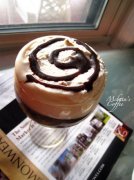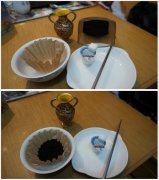Common sense of Coffee and several methods of brewing Coffee
Coffee common sense
Guo Ma
The basic classification of coffee
Italian: espresso (Espresso) extracted by a semi-automatic machine. Use it as the base to make fancy coffee, such as mocha, latte, cappuccino and so on.
Single coffee: coffee from a single origin (black coffee, black coffee). Such as Blue Mountain Coffee, Costa Rican Coffee, Mantening Coffee, Brazilian Coffee and so on.
American coffee: the coffee made by electric drip coffee machine is relatively light in appearance and taste.
Quality identification of coffee beans
The quality of coffee beans is rated by cup testers (CUPPER) of several international coffee auction organizations, and is divided into five grades: grade 1 (Cup of Excellence): more than 84 points, small yield rare specialty coffee beans (winning at auction); level 2 (Specially): more than 80 points, special coffee beans, accounting for only 2% of the total global coffee bean production ratio; level 3 (Good grade commercial): high-quality commercial beans Level 4 (Basic Commercial): ordinary commercial beans, the above two can be found in chain fast food coffee shops; level 5: ungraded coffee beans (Off-grade), poor quality or defective coffee beans.
How to buy and preserve coffee
Freshness, altitude, soil, climate, variety and grower's consciousness are all factors that determine the quality of coffee beans. When choosing and purchasing coffee beans, try to choose good varieties and detailed naming (naming method: origin + manor + varieties + organic or not, the more complete the information is, the higher the grade of coffee beans is, but some varieties are scattered by farmers. There may be no manor name), coffee beans with high freshness, about 1500 meters above sea level, suitable planting environment and suitable treatment.
When preserving coffee, consumers should pay attention to: the general raw beans should not be preserved for more than 1 year; the best drinking period after roasting is 4 weeks, preferably in contact with the air for more than 3 days, the flavor changes obviously within a week, and tends to be stable after a week, and the shelf life is 3 months; coffee beans should be consumed as soon as possible after grinding into powder. if the drinking speed is slow, you can grind or divide the coffee powder into small parts.
Several brewing methods of coffee
Huang Xiangwen
1. Pressure infiltration type:
When the water at 91 degrees Celsius touches the coffee powder, the soul of the coffee begins to wake up. This is a direct presentation of the true color of coffee beans, showing the nature and baking degree of coffee beans, the simplest and least skillful way of brewing, the so-called "lazy coffee". Use a glass pot with a filter on the top, pour in the coffee powder, heat the blister for about 4 minutes, press the pressure rod slowly, separate the coffee grounds and drink.
two。 Siphon:
The most dramatic scene in the process of turning a coffee bean into coffee, when the current rises, you hold your breath and expect that when it becomes coffee to fall, this is a classical and never-ending popular method of coffee extraction.
Using the siphon coffee pot, using the siphon principle, the boiling hot water is washed onto the coffee powder and stewed to produce the original flavor of the coffee.
3. Trickle filter:
Vietnamese coffee brewing method, which originated in France, is easy to operate. Add the coffee powder to the filter paper on the funnel; heat the water until the coffee powder is wet through; all the hot water flows into the pot and you can drink.
4. Italian style:
The extraction of each cup of Espresso (Italian concentrate) is a dialogue between classical technology and modern technology, and the appearance and taste of each cup of Espresso is also the general report of the physical examination of coffee beans. This is a high-pressure way, let the steam quickly pass through the coffee powder, extract the strong coffee, add the coffee powder to the coffee box in the middle, add water to the pot below, close the upper and lower pots, heat until all the water in the lower pot evaporates, pour out and drink.
5. Hand-driven:
First warm the coffee cup and brewing utensils, fold in half along the bottom edge and side sewing line of the filter paper, open the filter paper and place the filter paper on the filter paper, measure the coffee powder and pour it into the filter paper, and shake the filter cup left and right to make the coffee powder surface smooth. Wet the coffee surface evenly and slowly with hot water about 90 degrees Celsius, steam for 20-30 seconds, divide into 2-3 times from the center to the surrounding, and then slowly inject hot water like a circle from the four sides to the center.
6. Automatic percolation:
Use a drip coffee machine, use electricity to drive hot water, and use steaming to release coffee essence.
Important Notice :
前街咖啡 FrontStreet Coffee has moved to new addredd:
FrontStreet Coffee Address: 315,Donghua East Road,GuangZhou
Tel:020 38364473
- Prev

Three layers of creative coffee embellishes romantic Valentine's Day.
Mellow cream, bitter coffee, sweet chocolate, three flavors blend into one cup. Stir gently, watch the layers gradually disperse, take a breath and mix the fragrance. This is a very gentle cup of coffee on Valentine's Day.
- Next

Make a cup of coffee with a bowl, toothpick and coffee filter paper
The paper cup was used in the first cooking, and the leakage of coffee powder ended in failure. Learn from the lesson, this time use a bowl to hold coffee filter paper, boil it and lift it with a toothpick at the same time, the effect is relatively better.
Related
- How did the Salvadoran coffee industry develop in Central America?
- What exactly does the golden cup extraction of coffee mean?
- The Origin of Coffee flower
- [2023 Starbucks World Earth Day] there are more meaningful things besides free Starbucks coffee!
- What kind of coffee is there in Spain? 9 Flavors of Spanish Coffee
- Aromatic African coffee| Kenya's coffee culture and historical production area
- Liberica Coffee Bean knowledge: the characteristics of Liberian Coffee beans of the three original species of Coffee beans
- The origin and formula of Spanish latte introduces the taste characteristics of Bombon coffee in Valencia, Spain.
- How to adjust the solution of over-extracted coffee
- What is the tasting period of coffee beans? What is the period of coffee and beans? How should coffee wake up and raise beans?

